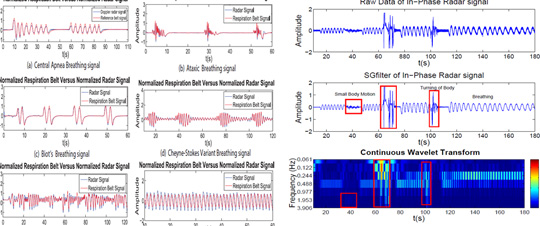
Non-contact detection characteristic of Doppler radar provides an unobtrusive means of respiration detection and monitoring. This avoids additional preparations such as physical sensor attachment or special clothing which can be useful for certain healthcare applications. Furthermore, robustness of Doppler radar against environmental factors such as light, ambient temperature, interference from other signals occupying the same bandwidth, fading effects, reduce environmental constraints and strengthens the possibility of employing Doppler radar in long term respiration detection and monitoring applications such as sleep studies. This paper presents an evaluation in the of use of microwave Doppler radar for capturing different dynamics of breathing patterns in addition to the respiration rate. Although finding the respiration rate is essential, identifying abnormal breathing patterns in real-time could be used to gain further insights into respiratory disorders and refine diagnostic procedures. Several known breathing disorders were professionally role played and captured in a real time laboratory environment using a non-contact Doppler radar to evaluate the feasibility of this non-contact form of measurement in capturing breathing patterns under different conditions associated with certain breathing disorders. In addition to that, inhalation and exhalation flow patterns under different breathing scenarios were investigated to further support the feasibility of Doppler radar to accurately estimate the tidal volume. The results obtained for both experiments were compared with the gold standard measurement schemes such as respiration belt and spirometry readings, yielding significant correlations with the Doppler radar based information. In summary, Doppler radar is highlighted as an alternative approach not only for determining respiration rates but also for identifying breathing patterns and tidal volumes as a preferred non-wearable alternative to the conventional contact sensing methods.
View full article

